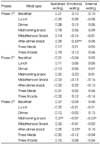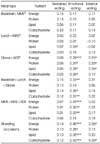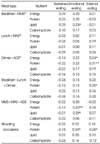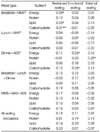Abstract
Objectives
The associations between the eating behavior and energy and macronutrient intake from meals and snacks consumed during different times of the day across the menstrual cycle were investigated in 74 healthy female college students.
Methods
A 9-day food record was collected during the last 3 days before menstrual onset (phase 1) and the first 3 days after menstrual onset (phase 2) and from the 4th to the 6th day after menstrual onset (phase 3), respectively. Anthropometry was assessed and eating behaviors were measured using the Dutch Eating Behavior Questionnaire (DEBQ).
Results
External eating was the most prevalent type of eating behavior, followed by restrained eating and emotional eating. Restrained eating was positively associated with energy, carbohydrate and lipid intake at the breakfast and midmorning snack during phase 3. However, emotional eating was also positively related to energy and macronutrient intake at the dinner and after-dinner snack during phase 1 and phase 3, with higher level detected in the phase 1. The association of emotional eating with the snack consumption was highest in phase 1. External eating was positively associated with energy and macronutrient intakes at the dinner and after-dinner snack across the three phases, the highest level being phase 1. In addition, restrained eating was positively associated with the weight, body mass index(BMI), fat mass, waist and hip girth of the subjects.
Conclusions
Eating behaviors varied with regard to meals and snacks consumed during different times of the day across the three menstrual phases. Dinner and afterdinner snack consumption in premenstrual phase could be considered as a time when women are more prone to overconsumption and uncontrolled eating.
Figures and Tables
Table 2
Comparison of the frequency of eating at different times of the day or meal type acoss the three menstrual phases

Table 3
Comparisons of mean energy and macronutrient intakes from different meal types of the three menstrual phases

1) Phase 1: Last 3 days before menstrual onset.
2) Phase 2: First 3 days after menstrual onset.
3) Phase 3: Three days from 4th to 6th day after menstrual onset.
4) MMS: Midmorning snack
5) MAS: Midafternoon snack
6) ADS: After-dinner snack
All values are not significantly different at p<0.05 by Duncan's multiple range test.
Table 4
Correlation between DEBQ1) scores and frequency of eating by different meal types across the three menstrual phases (n=74)

Table 5
Correlation between energy and macronutrient intake and DEBQ1) scores during Phase 12) of the menstrual phases (n=74)

Table 6
Correlation between energy and macronutrient intake and DEBQ1) scores during Phase 22) of the menstrual phases (n=74)

Table 7
Correlation between energy and macronutrient intake and DEBQ1) scores during Phase 32) of the menstrual phases (n=74)

References
1. De Castro JM. How can eating behavior be regulated in the complex environments of free-living human? Neurosci Biobehav Rev. 1996; 20(1):119–131.
2. Lake A, Townshend T. Obesogenic environments: exploring the built and food environments. J R Soc Promot Health. 2006; 126(6):262–267.
3. Virtanen M, Kivimaki H, Ervasti J, Oksanen T, Pentti J, Kouvonen A. Fast-food outlets and grocery stores near school and adolescents' eating habits and overweight in Finland. Eur J Public Health. 2015; 25(4):650–655.
4. Van Strien T, Frijters JE, Bergers G, Defares PB. The Dutch eating behavior questionnaire (DEBQ) for assessment of restrained eating, emotional, and external eating behavior. Int J Eat Disord. 1986; 5(2):295–315.
5. Elfhag K, Morey LC. Personality traits and eating behavior in the obese: Poor self-control in emotional and external eating but personality assets in restrained eating. Eat Behav. 2008; 9(3):285–293.
6. Rideout CA, McLean JA, Barr SI. Women with high scores for cognitive dietary restraint choose foods lower in fat and energy. J Am Diet Assoc. 2004; 104(7):1154–1157.
7. Burton P, Smit HJ, Lightowler HJ. The influence of restrained and external eating patterns on overeating. Appetite. 2007; 49(1):191–197.
8. Anschutz DJ, Van Strien T, Van De Ven MOM, Engels RCME. Eating styles and energy intake in young women. Appetite. 2009; 53(1):119–122.
9. Beiseigel JM, Nickols-Richardson SM. Cognitive eating restraint scores are associated with body fatness but not with other measures of dieting in women. Appetite. 2004; 43(1):47–53.
10. Keskitalo K, Tuorila H, Spector TD, Cherkas LF, Knaapila A, Kaprio J. The three-factor eating questionnaire, body mass index, and responses to sweet and salty fatty foods: a twin study of genetic and environmental associations. Am J Clin Nutr. 2008; 88(2):263–271.
11. Leblanc V, Provencher V, Begin C, Gagnon-Girouard MP, Corneau L, Tremblay A. Associations between eating patterns, dietary intakes and eating behaviors in premenopausal overweight women. Eat Behav. 2012; 13(2):162–165.
12. Pla-Sanjuanelo J, Ferrer-Garcia M, Gutierrez-Maldonado J, Riva G, Andreu-Gracia A, Dakanalis A. Identifying specific cues and contexts related to bingeing behavior for the development of effective virtual environments. Appetite. 2015; 87:81–89.
13. O'Connor DB, Jones F, Conner M, McMillan B, Ferguson E. Effects of daily hassles and eating style on eating behavior. Health Psychol. 2008; 27:1 Suppl. S20–S31.
14. Yonkers KA, O'Brien PMS, Eriksson E. Premenstrual syndrome. Lancet. 2008; 371(9619):1200–1210.
15. Klump KL, Keel PK, Racine SE, Burt SA, Neale M, Sisk CL. The interactive effects of estrogen and progesterone on changes in emotional eating across the menstrual cycle. J Abnorm Psychol. 2013; 122(1):131–137.
16. Martini MC, Lampe JW, Slavin JL, Kurzer MS. Effect of the menstrual cycle on energy and nutrient intake. Am J Clin Nutr. 1994; 60(6):895–899.
17. Cheikh Ismail LI, AI-Hourani H, Lightowler HJ, Aldhaheri AS, Henry CJ. Energy and nutrient intakes during different phases of the menstrual cycle in females in the United Arab Emirates. Ann Nutr Metab. 2009; 54(2):124–128.
18. Ko CH, Yen CF, Long CY, Kuo YT, Chen CS, Yen JY. The lateluteal leptin level, caloric intake and eating behaviors among women with premenstrual dysphoric disorder. Psychoneuroendocrinology. 2015; 56:52–61.
19. Gorczyca AM, Sjaarda LA, Mitchell EM, Perkins NJ, Schliep KC, Wactawski-Wende J. Changes in macronutrient, micronutrient, and food group intakes throughout the menstrual cycle in healthy, premenopausal women. Eur J Nutr. 2016; 55(3):1181–1188.
20. Yen JY, Chang SJ, Ko CH, Yen CF, Chen CS, Yeh YC. The high-sweet-fat food craving among women with premenstrual dysphoric disorder: Emotional response, implicit attitude and rewards sensitivity. Psychoneuroendocrinology. 2010; 35(8):1203–1212.
21. Klump KL, Keel PK, Burt SA, Racine SE, Neale MC, Sisk CL. Ovarian hormones and emotional eating associations across the menstrual cycle: an examination of the potential moderating effects of body mass index and dietary restraint. Int J Eat Disord. 2013; 46(3):256–263.
22. Steiner M, Macdougall M, Brown E. The premenstrual symptoms screening tool(PSST) for clinicians. Arch Women Ment Health. 2003; 6(3):203–209.
23. Almoosawi S, Winter J, Prynne CJ, Hardy R, Stephen AM. Daily profiles of energy and nutrient intakes: are eating profiles changing over time? Eur J Clin Nutr. 2012; 66(6):678–686.
24. Leech RM, Worsley A, Timperio A, McNaughton SA. Characterizing eating patterns: a comparison of eating occasion definitions. Am J Clin Nutr. 2015; 102(5):1229–1237.
25. Kim HJ, Lee IS, Kim JH. A study of the reliability and validity of the Korean version of the eating behavior questionnaire. Korean J Clin Psychol. 1996; 15(1):141–150.
26. Song YM, Lee KY, Sung JH. Eating behaviors and weight over time in a prospective study: the Healthy Twin Study. Asia Pac J Clin Nutr. 2014; 23(1):76–83.
27. Baños RM, Cebolla A, Moragrega I, Van Strien T, Fernandez-Aranda F, Aguera Z. Relationship between eating styles and temperament in an anorexia nervosa, healthy control, and morbid obesity female sample. Appetite. 2014; 76:76–83.
28. Dakanalis A, Zanetti MA, Clerici M, Madeddu F, Riva G, Caccialanza R. Italian version of the Dutch Eating Behavior Questionnaire. Psychometric proprieties and measurement invariance across sex, BMI-status and age. Appetite. 2013; 71:187–195.
29. The Korean Nutrition Society. Dietary reference intakes for Korean. 2nd revision. Seoul: The Korean Nutrition Society;2015. p. 26–60.
30. Reed SC, Levin FR, Evans SM. Changes in mood cognitive performance and appetite in the late luteal and follicular phases of the menstrual cycle in women with and without PMDD (premenstrual dysphoric disorder). Horm Behav. 2008; 54(1):185–193.
31. Cross GB, Marley J, Miles H, Willson K. Changes in nutrient intake during the menstrual cycle of overweight women with premenstrual syndrome. Br J Nutr. 2001; 85(4):475–482.
32. Bryant M, Truesdale KP, Dye L. Modest changes in dietary intake across the menstrual cycle: implications for food intake research. Br J Nutr. 2006; 96(5):888–894.
33. Kim SY, Cha BK, Park PS. Energy and macronutrient intakes during menstrual cycle in young women. Korean J Community Nutr. 1998; 3(2):210–217.
34. Wang JB, Patterson RE, Ang A, Emond JA, Shetty N, Arab L. Timing of energy intake during the day is associated with the risk of obesity in adults. J Hum Nutr Diet. 2014; 27:Suppl 2. 255–262.
35. Reeves S, Huber JW, Halsey LG, Horabady-Farahani Y, Ijadi M, Smith T. Experimental manipulation of breakfast in normal and overweight/obese participants is associated with changes to nutrient and energy intake consumption patterns. Physiol Behav. 2014; 133:130–135.
36. Van Strien T, Herman CP, Verheijden MW. Eating style, overeating, and overweight in a representative Dutch sample. Does external eating play a role? Appetite. 2009; 52(2):380–387.
37. Moreira P, de Almeida MD, Sampaio D. Cognitive restraint is associated with higher intake of vegetables in a sample of university students. Eat Behav. 2005; 6(3):229–237.
38. Oliver G, Wardle J, Gibson EL. Stress and food choice: a laboratory study. Psychosom Med. 2000; 62(6):853–865.
39. Dweck JS, Jenkins SM, Nolan LJ. The role of emotional eating and stress in the influence of short sleep on food consumption. Appetite. 2014; 72:106–113.
40. Huh J, Shiyko M, Keller S, Dunton G, Schembre SM. The timevarying association between perceived stress and hunger within and between days. Appetite. 2015; 89:145–151.
41. Barnes TL, French SA, Harnack LJ, Mitchell NR, Wolfson J. Snacking behaviors, diet quality, and body mass index in a community sample of working adults. J Acad Nutr Diet. 2015; 115(7):1117–1123.
42. Van Strien T, Winkens L, Toft MB, Pedersen S, Brouwer I, Visser M. The mediation effect of emotional eating between depression and body mass index in the two European countries Denmark and Spain. Appetite. 2016; 105:500–508.
43. Richardson AS, Arsenault JE, Cates SC, Muth MK. Perceived stress, unhealthy eating behaviors, and severe obesity in lowincome women. Nutr J. 2015; 14(1):122–131.
44. Burton P, Smit HJ, Lightowler HJ. The influence of restrained and external eating patterns on overeating. Appetite. 2007; 49:191–197.
45. Cebolla A, Barrada JR, Van Strien T, Oliver E, Banos R. Validation of the Dutch eating behavior questionnaire (DEBQ) in a sample of Spanish women. Appetite. 2014; 73:58–64.
46. Bray GA. Reciprocal relation of food intake and sympathetic activity: experimental observations and clinical implications. Int J Obes Relat Metab Disord. 2000; 24:Suppl 2. S8–S17.
47. Blondheim DS, Blondheim O, Blondheim SH. The dietary composition of pre-fast meals and its effect on 24 hour food and water fasting. Isr Med Assoc J. 2001; 3(9):657–662.
48. Shapiro D, Jamner LD, Goldstein IB. Daily mood states and ambulatory blood pressure. Psychophysiology. 1997; 34(4):399–405.
49. Church DD, Hoffman JR, LaMonica MB, Riffe JJ, Hoffman MW, Baker KM. The effect of an acute ingestion of Turkish coffee on reaction time and time trial performance. J Int Soc Sports Nutr. 2015; 12(1):37–47.
50. Marczinski CA, Stamates AL, Ossege J, Maloney SF, Bardgett ME, Brown CJ. Subjective state, blood pressure, and behavioral control changes produced by an "Energy Shot". J Caffeine Res. 2014; 4(2):57–63.
51. Lee RD, Nieman DC. Nutritional assessment. 3rd ed. New York: McGraw-Hill;2003. p. 361–363.




 PDF
PDF ePub
ePub Citation
Citation Print
Print





 XML Download
XML Download